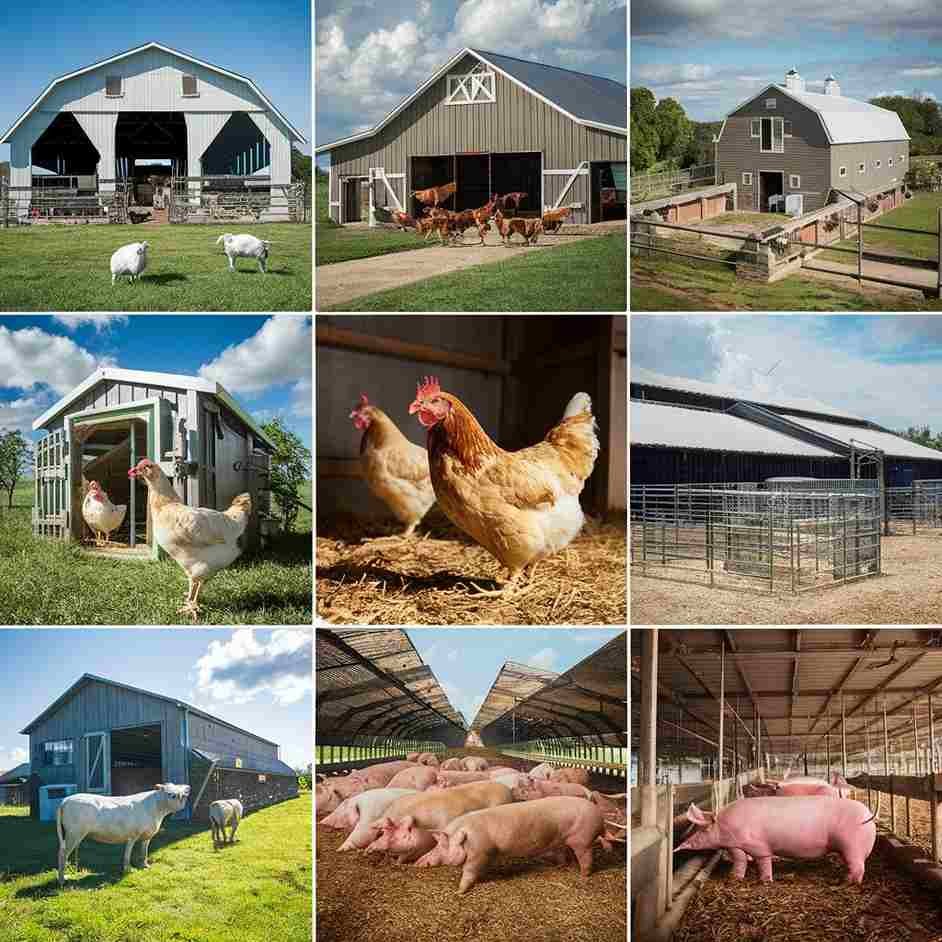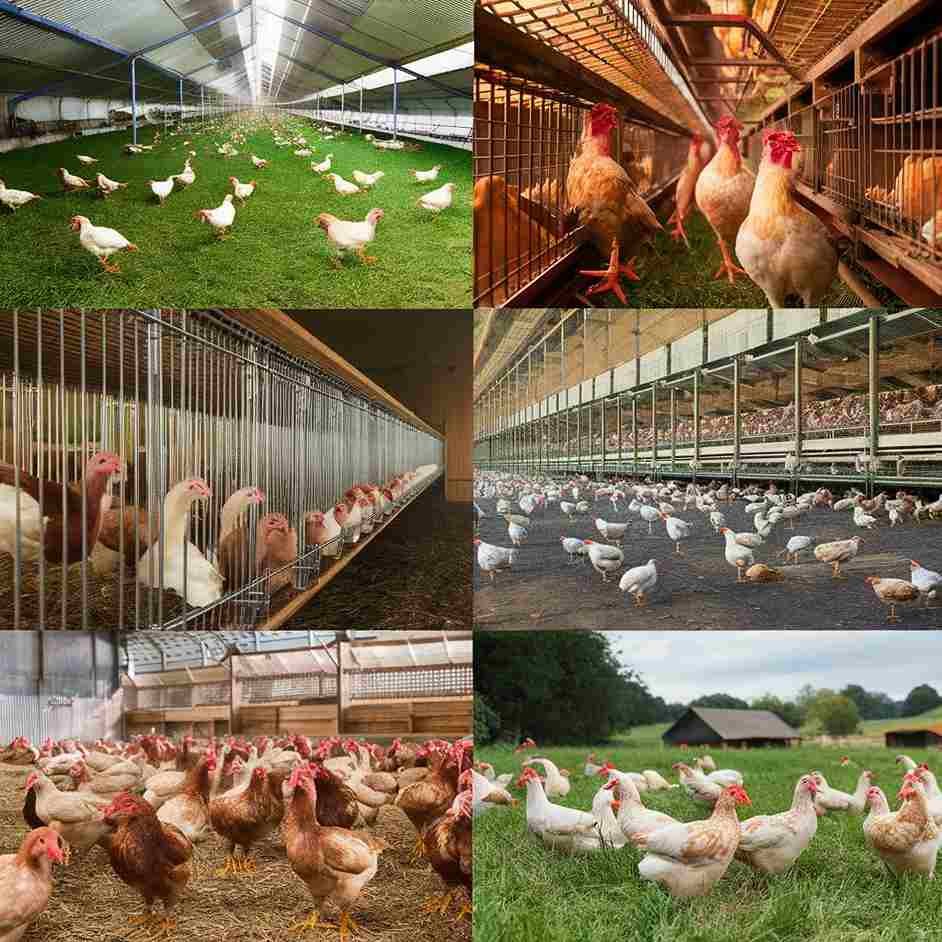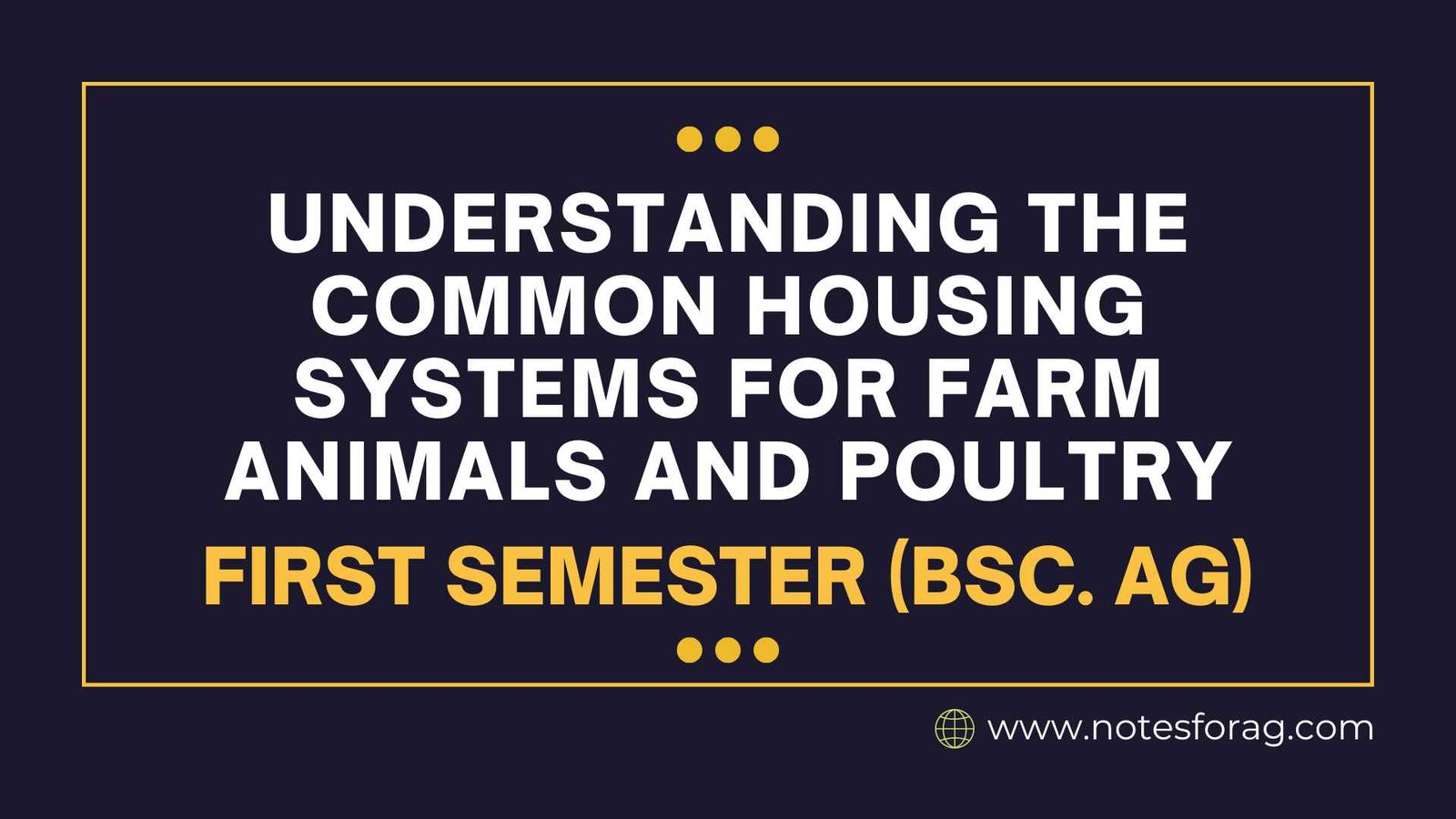For farm animals and poultry, common housing systems are intended to provide adequate living circumstances that will guarantee their production, welfare, and health. Free-stall barns, open sheds, pasture-based systems, and stables are examples of housing options for farm animals such as cattle, sheep, goats, pigs, and horses. Animals kept in systems like deep litter, free-range, cage-free, and aviaries include chickens, ducks, turkeys, geese, quails, and pigeons. Customized to each species’ unique requirements, these systems strike a balance between good management techniques and animal welfare.
Table of Contents
Introduction to Farm Animal and Poultry Housing
Proper housing is a fundamental aspect of animal husbandry, critical for both farm animals and poultry. The main goal of housing systems is to give animals a secure and cozy habitat that satisfies their fundamental needs. The ability to provide shelter from bad weather is one of housing’s primary purposes. A well-designed shelter keeps animals comfortable and reduces stress, regardless of the weather-extreme heat, cold, rain, or snow. This preserves the animals’ health and productivity.
Protecting animals from predators is another essential function of housing. Livestock and poultry are susceptible to a range of predators, encompassing both wild and domesticated animals. Secure housing reduces the possibility of attacks, which lowers losses and guarantees the animals’ protection. Furthermore, by supporting improved cleanliness and biosecurity protocols, suitable housing helps avoid disease. The occurrence of infections can be considerably decreased, improving the animals’ general well-being, by proper ventilation, space allocation, and sanitary measures within the housing. The housing systems of different Farm Animals and Poultry are described below:
Types of Housing Systems for Different Farm Animals

Different farm animal species are housed in different ways, with each system created to address certain requirements of animal welfare, production, and environmental factors. Traditional pasture-based arrangements and more contemporary confinement operations are examples of these housing systems. Let’s explore the housing systems used for cattle, pigs, sheep, and goats, along with their respective advantages and disadvantages.
1. Cattle
Cattle housing systems are designed to provide a safe, comfortable, and healthy environment for the animals while facilitating efficient management and productivity. Here are the common types of housing systems for cattle:
- Free-Stall Barns: Individual stalls for cows allow them to lie down and move around without restriction. This is a typical dairy farming scheme.
- Tie-Stall Barns: Here, cows are milked, fed, and rested while tethered to separate stalls.
- Pasture-Based Systems: During the majority of the year, cattle graze on pasture; in severe weather, they are given with shelter.
2. Sheep
Sheep housing systems are designed to provide a safe, comfortable, and healthy environment for the animals, accommodating their needs for shelter, grazing, and lambing. Here are the common types of housing systems for sheep:
- Open Sheds or Barns: Allow for unrestricted mobility while offering shelter from inclement weather.
- Pasture-Based Systems: During severe weather or the time leading up to lambing, sheep graze on fields where they have access to cover.
- Fold Systems: Sheep grazing areas are rotated using foldable fencing, which lowers parasite burdens and provides fresh feed.
3. Goats
Housing systems for goats are made to meet their specific needs and to offer a safe, cozy, and healthy habitat. Goats need proper shelter to be safe from bad weather and predators, as well as to ensure their general wellbeing. Here are the common housing systems for goats:
- Open Sheds: Easy-to-build shelters that shield goats from inclement weather and wind.
- Pasture-Based Systems: With access to shelters, goats graze and browse on pastures.
- Barns with Pens: Offer distinct spaces for bedding, eating, and kidding (childbirth).
4. Pigs
Pig housing systems, which offer comfort, protection, and a favorable environment for growth and reproduction, are essential elements of the contemporary pig industry. Here are the common housing systems for pigs:
- Indoor housing: Often seen in commercial settings, this type of housing consists of pens or stalls with regulated surroundings.
- Outside Systems: Pigs are housed in paddocks or fenced areas with access to sheds or other covered facilities.
- Pasture-Based Systems: Pigs are allowed to forage and roam around freely, and they have access to protected shelters.
5. Horses
The housing systems for horses are made to fulfill their specific needs while offering a secure, cozy, and healthful environment. Here are the common housing systems for horses:
- Barns or stables: Separate stalls that offer each horse protection and a regulated atmosphere.
- Pasture-Based Systems: In these systems, horses can graze in pastures with run-in sheds or shelters nearby.
- Combination Systems: Horses can graze or work out outside while being stabled part-time.
Every farm animal housing method has advantages and disadvantages of its own. Modern systems typically place a higher priority on productivity and simplicity of management than traditional systems, which frequently emphasize animal welfare and natural living circumstances. Achieving the ideal balance is essential for ethical and sustainable farming methods.
Poultry Housing Systems

Proper poultry housing is essential for maintaining flock health, maximizing egg and meat production, and supporting sustainable and humane poultry farming practices.
1. Chickens
Poultry housing systems for chickens are essential for ensuring their health, welfare, and productivity.
- Battery Cages: Hens are housed in tiny cages under the traditional arrangement for layers. Welfare concerns are causing a gradual phase-out of this system.
- Deep Litter Systems: Perches and nesting places are available to birds housed on a floor covered in litter.
- Free-Range Systems: At night, the hens are kept in shelters and have access to outdoor spaces during the day.
- Cage-Free Systems: In these systems, hens live indoors but are not kept in cages, giving them greater mobility.
2. Ducks
Poultry housing systems for ducks are designed to provide a safe, comfortable, and healthy environment, promoting their welfare and productivity.
- Barn Systems: Ducks are housed inside on flooring covered in litter, with access to water for bathing and drinking.
- Free-Range Systems: Water sources and open spaces are available to ducks so they can swim and forage.
3. Turkeys
Turkeys require specialized housing that satisfies their demands and is safe, cozy, and productive. This requires poultry housing systems.
- Barn Systems: Turkeys are grown indoors in spacious, roomy quarters.
- Free-Range Systems: Turkeys can forage outside in designated areas.
4. Geese
To ensure the health and productivity of geese, poultry housing systems are specifically built to satisfy their needs in terms of space, protection, and access to water.
- Pasture-Based Systems: On pastures with access to shelters, geese graze.
- Barn Systems: Geese are kept inside and have access to water for bathing and drinking.
5. Quails
The purpose of poultry housing systems for quails is to offer a safe, cozy, and favorable environment for their development and egg production.
- Cage Systems: Quails are housed in regulated environments within cages.
- Deep Litter Systems: Quails are raised on spacious floors covered in litter.
6. Pigeons
Pigeon housing systems are specifically engineered to offer a secure, cozy, and engaging atmosphere that caters to their individual requirements.
- Lofts: Lofts are used to house pigeons and offer them space for flying, perches, and nesting boxes.
- Aviaries: Huge enclosures that permit flight and more natural behaviors.
For farm animals and poultry, common housing systems offer secure and cozy settings that are customized to meet the requirements of each species. Free-stall barns, open sheds, pasture-based systems, and stables are common configurations for agricultural animals such as cattle, sheep, goats, pigs, and horses. Battery cages, deep litter systems, free-range arrangements, barns, and aviaries are examples of poultry housing for chickens, ducks, turkeys, geese, quails, and pigeons. In addition to fostering productivity and health, Farm animals and poultry systems encourage humane and sustainable agricultural methods by providing shelter from the elements, access to food and water, and room for mobility.
Frequently Asked Question(FAQ)
Why is proper housing important for farm animals and poultry?
Appropriate housing is essential for safeguarding animals against bad weather, guaranteeing their health and welfare, enabling effective management, and encouraging output. By attending to the unique demands of every species, it promotes humane and sustainable farming methods.
What are the main housing systems for chickens?
Battery cages, deep litter systems, cage-free systems, and free-range systems are the spaces where chickens are kept. A range of room, independence, and outdoor environment access are offered by these configurations.
Related Articles

